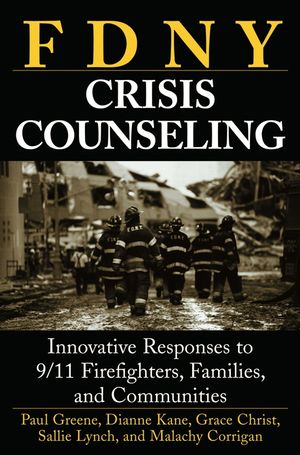FDNY Crisis Counseling: Innovative Responses to 9/11 Firefighters, Families, and CommunitiesISBN: 978-0-471-71425-5
Paperback
288 pages
April 2006
 This title is out-of-print and not currently available for purchase from this site.
|
Preface xiii
Acknowledgments xix
Chapter 1 Introduction 1
Chapter 2 Coping with Chaos 10
The Counseling Service Unit Pre-9/11 11
The CSU Response to 9/11 16
Assessing the Community 18
Receiving Outside Help 21
CSU Expansion 23
Connecting with the Firefighting Community 23
Connecting with Families 24
Family Liaisons 26
Moving Forward 29
Defining a Timeline for Your Community 30
Chapter 3 Understanding Culture 33
Cultural Identity 35
Applying Cultural Identity to Intervention 37
Firefighting History and Tradition in New York 39
Modern Firefighting in New York City 45
The FDNY as a Paramilitary Organization 47
Everyday Life in the Firehouse 48
Rituals and Rank 50
Common Bonds 54
Family Ties That Bind 56
Heroics, Media, and Politics 60
The Brotherhood and Its Loss 63
Chapter 4 Shaping Services to Meet Emerging Needs 68
Assessment and Planning 69
How the Nature of the Event Shapes the Response 74
Listening and Responding to Emerging Needs 79
Strengthening the CSU Identity 82
Establishing Provider Networks 83
Building a Staff: Both Peer and Professional 87
Care for the Caregivers 90
Keeping the Machinery Going: Funding and Resource Development 95
Thoughts for the Future 96
Chapter 5 Providing Help in the Workplace: The Firehouse Clinician Project 98
The Mindset of FDNY Firefighters 98
The Intervention: Placing Clinicians in Firehouses 100
The Population: Defining Who Needed Services 103
Theoretical Orientation 106
Intervention Goal 107
Selecting and Training Firehouse Clinicians 111
The First Visit to the Firehouse 115
Revamping Professional Boundaries 120
Preparing to Be a Firehouse Clinician 125
Termination Countertransference: The Time to Leave the Firehouse 134
Chapter 6 Modifying Psychotherapy for Individuals 136
Individual Psychotherapy with Firefighters 136
The Parameters of Individual Treatment 140
Choosing Individual Psychotherapy 143
Implications for Psychotherapy Technique 149
Summary 153
Chapter 7 Finding Comfort in Groups 154
Why Group Intervention? 155
Therapy Groups versus Support Groups 156
Trauma Groups 156
On-Site Interventions 159
Office-Based Groups: Middle and Later Phase 162
Importance of Homogeneity in Group Formation 164
Traumatic Bereavement Groups 165
Single-Session Groups 176
A Final Word about Groups 178
Chapter 8 Providing a Home-Based Therapeutic Program for Widows and Children 180
Understanding the Experience for Mothers and Children 181
Developing CSU Services for Bereaved Families 187
Creating a Preliminary Model for the Family Program 189
Preliminary Trauma, Grief, Reconstitution Model 191
Implementing the Family Program 196
Intervention Goals for Children and Adolescents 198
Intervention Goals for Adults 199
Therapeutic Approaches 199
Lessons Learned 207
Chapter 9 Strengthening Connections within the Family at Home 212
The Impact of Trauma on Relationships 215
Reaching Out to Families 217
Developing an Effective Intervention 219
The Couples Connection Weekend 220
Lessons Learned 228
Chapter 10 Assisting Retirees in Transition 231
When the Losses of 9/11 Were Compounded by the Loss of a Job 231
The Retiree Experience 234
The Stay Connected Program 236
Lessons Learned 243
Chapter 11 Conclusion 246
Protracted Time Lines 248
Community of Grievers 249
Crisis Counseling over the Long Haul 250
Public versus Private Mourning 251
The Value of Pre-planning 253
Posttraumatic Growth 255
Postscript 257
References 259
Index 265



